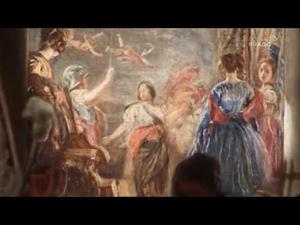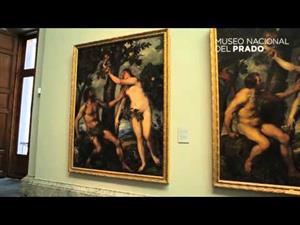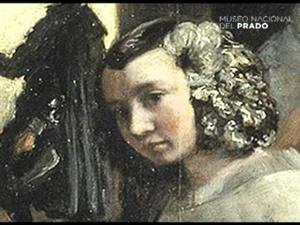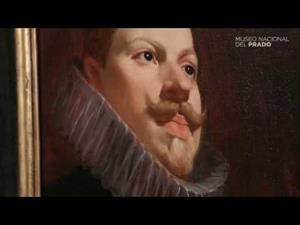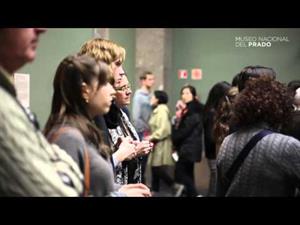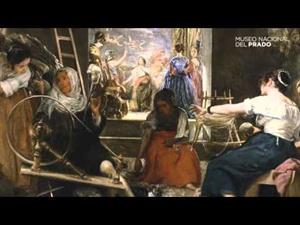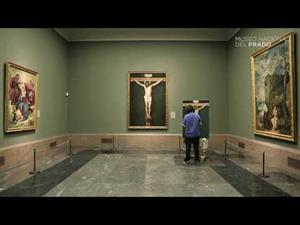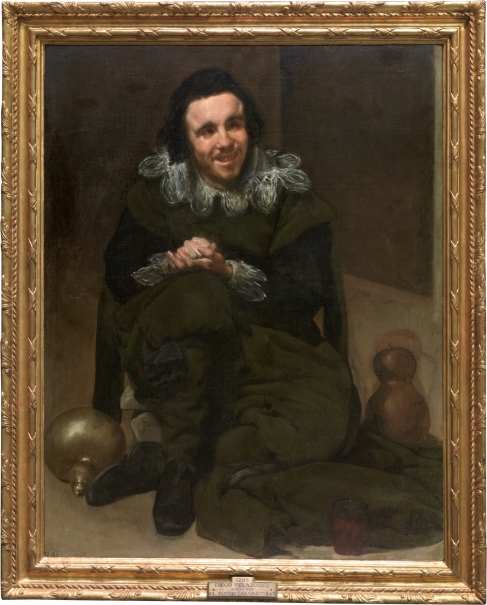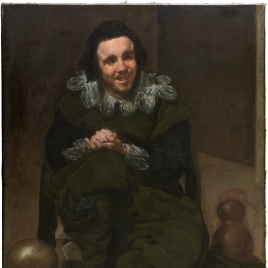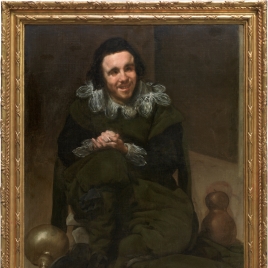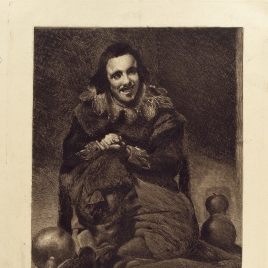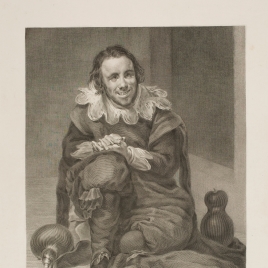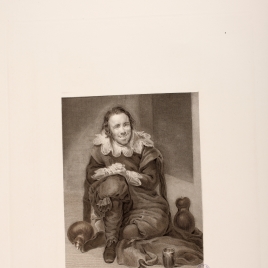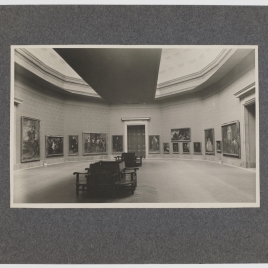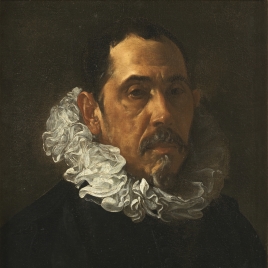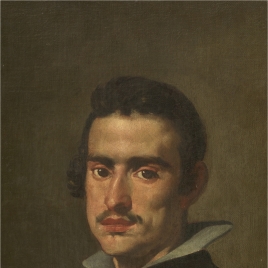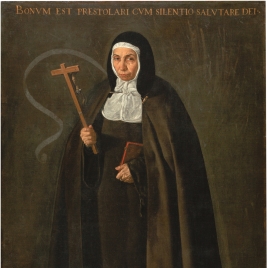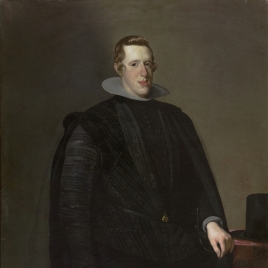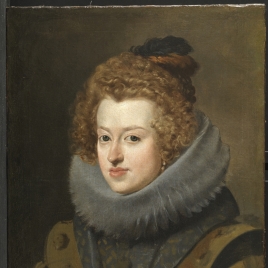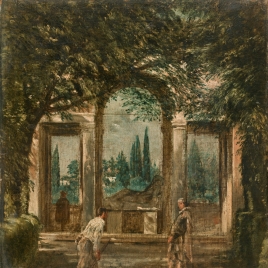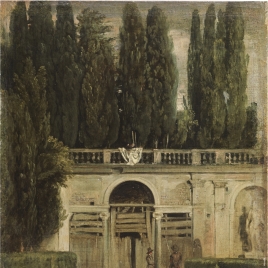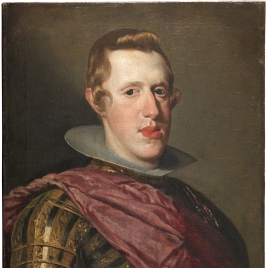The Buffoon Calabacillas
1635 - 1639. Oil on canvas.On display elsewhere
One of the most unique and distinctive areas within Velázquez`s oeuvre is that of his portraits of buffoons, dwarves and individuals collectively known as hombres de placer (men of pleasure). There were indispensable figures in the social structure of Spanish royal palaces and functioned as a crucial counterpoint in the markedly hierarchical and protocol-based system that governed court life. With their witty sallies, bizarre behaviour and physical and psychological peculiarities they offered a permanent image of a carnivalesque world: that of the other. As such, Velázquez depicted them by emphasizing their otherness through both the compositions and the pictorial handling of which he made use.
Among these portraits, the group that offers the most overt proof of Velázquez`s pictorial liberty is the one comprising four images of similar dimensions that depict four seated figures. Three of them are recorded in 1700 in the Torre de la Parada, a royal pavilion for which Rubens executed a large cycle of mythological paintings. The fact that two of these portraits, El Niño de Vallecas and El Primo (both Museo del Prado), include views of the Sierra de Guadarrama suggests that they were specifically painted for the pavilion, which was located to the north of Madrid and looked directly onto the Sierra.
The present painting is one of these three and was still in the Torre de la Parada in 1747. While the sitter`s identity has been questioned on occasions and it has been suggested that this is not a portrait, all of Velázquez`s portraits of buffoons can be identified as particular individuals and it is logical to assume they are all portraits given the number of such figures at court and the long-established tradition of portraying them. With regard to this sitter`s name, the presence of a gourd next to him has led to his identification as Juan Calabazas (John Gourds),a buffoon documented at the Madrid court from 1632 to his death in 1639. There are also references to two other portraits of him. Supporting this identification is the fact that Velázquez made play on other occasions with the names of these men of pleasure when depicting them, namely with Juan de Austria (P1200), who is depicted as his military counterpart, and his pair Barbarroja (Redbeard) (P01199).
As Fernando Bouza has noted, the term calabaza frequently appears in contexts related to buffoons, and the present figure in the service of Phillip IV was not the first of that time. In 1543, for example, a buffoon of this name is recorded in the service of the Duke of Medina Sidonia. The reasons for this choice of name lie in the connotations associated with gourds or pumpkins, which were frequently used to refer to madness, lack of sense or rashness. Here Velázquez has constructed a more complex referential system: the gourd not only identifies the figure in all likelihood but also functions to characterize him psychologically and to create a discourse on wine and its effects, to which the glass in the foreground contributes. In fact, it is evident to the naked eye that the artist initially painted an earthenware jug before including the gourd. At this period, gourds of this type were most commonly used to hold liquids.
In addition to the objects located next to him, the characterization of this sitter as a buffoon is constructed through a range of devices directly relating to his clothing and gestures. The green of his suit was appropriate for court buffoons, while the position of his body, crouching on the ground, and that of his hands would be unthinkable in a portrait of any other type of sitter. As Angulo suggested, in the creation of this pose Velázquez probably made use of Durer`s print of The Desperate Man, from which he derived the position of the lower part of the body.
In general, Velázquez`s court portraits are characterized by the use of a limited range of expressions. In most of them the artist established a remarkable communicatory distance between the model and viewer and there is an almost complete absence of empathy. The only exception prior to his second trip to Italy is the group of buffoons, in which we encounter a wider range of expressions and in which interaction with the viewer is frequently sought out. The present portrait was described in the eighteen century as a laughing dwarf and can indeed be considered one of the very few examples of portraits by the artist to include a facial gesture of this type, which was forbidden in the representation of a member of the royal family or nobility.
This otherness and artistic liberty to be appreciated in the expression is also evident in another aspect of the face. In general, Velázquez allowed himself a considerable degree of freedom when depicting buffoons, but this is the most extreme example, given that he shows Calabazas`s face seemingly out of focus. This approach is thus similar to that found in Mars (Museo del Prado, P01208 ), which is also associated with the Torre de la Parada and in which the artist played with blurring the limits between the body and its surroundings. Velázquez mad use of procedures of this type to experiment with painting`s potential to convey the sensation of life and movement.
Calabazas is undoubtedly Velázquez`s most radical portrait. This radicality derives from a combination of an unprecedented pose of a type not to be expected in a portrait, with the use of a high viewpoint; a body language that emphasizes alienation; a range of expressions that are disturbing in a portrait and which interact with the viewer; the inclusion of intriguing objects; and a setting (the corner of a room) that functions to isolate the model and directly confront us with him. In contrast to the closed, codified and controlled system of meanings and expressions on which the court portrait was based, a semantic ambiguity prevails in this portrait of Calabazas, transforming the work itself into a question. For all these reasons, it is one of the most unique portraits produced in Europe at this period and among the finest examples of Velázquez`s independent thinking (Text from Portús, J.: Velázquez, Kunsthistorisches Museum, Wien, 2014, pp. 310-311).



